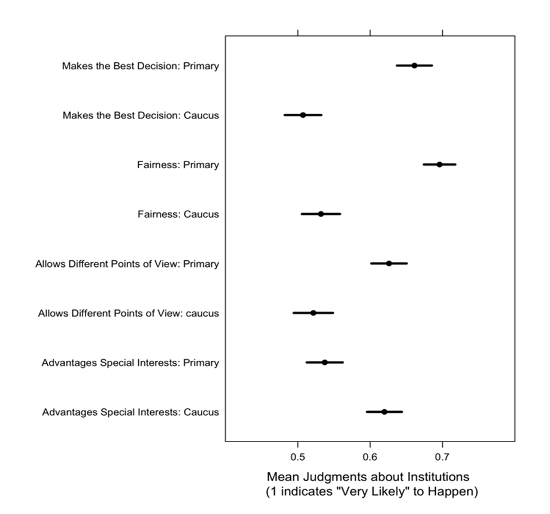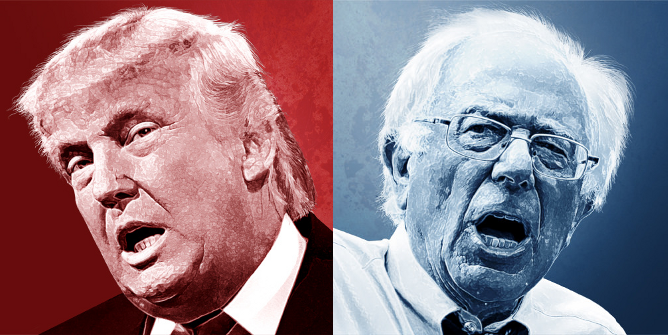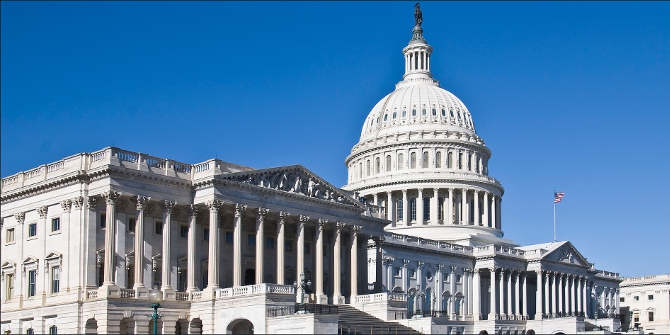
 The next 19 months will see nearly endless speculation over the candidates and the outcome of the 2016 presidential election. But how important is the nomination process? In new research on presidential primaries and caucuses using data from the Cooperative Congressional Election Study, Christopher F. Karpowitz & Jeremy C. Pope find that compared to primaries, caucuses are seen by many voters as being less fair and more likely to advantage special interests, making them less representative, and more likely to attract more partisan voters. This in turn means that caucuses are more likely to select a more extreme nominee.
The next 19 months will see nearly endless speculation over the candidates and the outcome of the 2016 presidential election. But how important is the nomination process? In new research on presidential primaries and caucuses using data from the Cooperative Congressional Election Study, Christopher F. Karpowitz & Jeremy C. Pope find that compared to primaries, caucuses are seen by many voters as being less fair and more likely to advantage special interests, making them less representative, and more likely to attract more partisan voters. This in turn means that caucuses are more likely to select a more extreme nominee.
In recent days and weeks, media outlets have been filled with stories exploring the attributes and issues positions of the emerging crop of presidential candidates. These stories are an important prelude to the nomination process, allowing interested voters to begin informing themselves about their choices. As 2008’s protracted nomination fight showed, however, the attributes of the candidates are not the only determinant of election outcomes: the process itself matters too. In the Democratic nomination contest that year, Barack Obama’s margin of victory over Hillary Clinton was largely due to his success in states that used a caucus (where registered party members gather to discuss and nominate delegates to the national convention) rather than a primary (where voters, usually party members, vote to select the candidate) to choose delegates to the party convention (and thus to choose the nominee). The effect of process choices was on clear display in Texas, where Hillary Clinton won a narrow victory among voters who participated in the state’s primary in the morning but lost by 13 points among the subset of voters who attended the caucuses later that same evening. With a large number of candidates and no clear front-runner on the Republican side, at least, these sometimes neglected differences between primaries and caucuses are worth watching closely again in 2016.
Politicians know that the nomination system can matter, and in the lead-up to the 2016 race, several states considered changing their procedures as a way of nudging the election outcome one way or another. In Kentucky, for example, some Republican officials felt that a move to a caucus might benefit Senator Rand Paul in his potential bid for the presidency. In the end, few changes occurred, and some prominent Republicans, like the 2012 Republican presidential candidate, Mitt Romney, expressed alarm at the prospect of more caucuses. Romney told the Boston Globe that he opposed moves toward more caucuses and conventions because “primaries are the place where you see whose message is connecting with the largest number of people.” Romney’s stated argument is about the sheer numbers of people participating, but the larger question (and perhaps the subtext of Romney’s alarm) is whether one procedure is more representative than the other. Do caucuses benefit more ideologically extreme candidates at the expense of moderates? In new research, we find that they do, and that they are also less representative compared to primaries.
The intuition that primaries are more representative than caucuses is enticing, but previous political science research on this point had been inconclusive, with some concluding that caucuses were more ideologically extreme and others casting doubt on the notion that the caucus system is “overwhelmed by ideologues.” The problem, though, is that the point of comparison matters, and because nomination procedures differ by state (though Texas has a dual primary and caucus system), previous research had rarely compared the policy views of primary and caucus voters with each other.
We tackled this question with the help of data from the Cooperative Congressional Election Study (CCES) in 2008, using an experiment in which we randomly assigned individuals to either a primary or caucus condition and briefly explained the basics of the assigned nominating procedure. We then asked respondents to think forward to the next time their party nominates a candidate, to evaluate different features of the process to which they had randomly been assigned, and to indicate their likelihood of participating in it. We found that those who had actually participated in the caucus system in the past were especially fond of it, but almost everyone else had deep concerns, regardless of how strong their partisan attachments happened to be. Respondents assigned to the caucus condition in our experiment judged caucuses as less likely to result in the “best decisions,” less likely to be fair, less friendly to different points of view, and more likely to advantage special interests, compared to the judgments of respondents assigned to the primary condition (see Figure 1).
Figure 1 – Respondents’ judgments about primary and caucus elections

These differences in assessments of the procedure are interesting by themselves, but we also asked respondents how likely they would be to participate in the caucus or primary procedure to which they had been randomly assigned if their state adopted it for the next presidential nominating contest. Regardless of whether they were strong partisans or not, rates of expected participation were much higher among those in the primary condition than among those asked to think about caucuses. Such a difference in participation rates might not be a problem if caucuses were smaller, but still representative gatherings. However, caucuses did not depress participation equally. Instead, caucuses were especially off-putting to less ideologically consistent and more moderate voters. In other words, while primaries attracted more voters, they also attracted a more representative sample of voters. Caucuses, on the other hand, were places that attracted a disproportionate number of ideologically extreme citizens, even after controlling for many other factors that might affect participation.
Of course, these are voters’ self-reports of “likely participation” in a hypothetical future election. To check our experimental findings, we also needed to see evidence of these trends in the real world. We therefore made use of the fact that the CCES includes a very large number of respondents, including more than 9,000 who actually attended caucuses and primaries in 2008. Thus, we were able to compare the levels of ideological extremism among actual caucus-goers to the level among primary voters. Using these observational data and controlling for strength of partisanship, political knowledge, past participation, and demographic variables, we again find that caucus attenders are ideologically quite extreme compared to their counterparts who voted in primaries. With respect to their positions on the issues, caucus attenders look a lot more like the ideologically polarized members of Congress than they do average Republicans or Democrats.
As long as we’re talking about a primary election the number of voters who participate is still quite high, but when we shift to a caucus the number of participators is a much, much smaller group. Size of the group is not the only thing that matters, however. Caucus-goers are also a much more ideological group. They are simply more likely to let through an extreme nominee, someone not a sound choice for the general election. Of course there may be times when a strong, ideologically-driven attachment to a set of policies is better than the less ideologically consistent views of the sometimes mushy middle—but when we choose our nomination process, we are making a profound choice about whose views will be represented and whose will not.
Perhaps, then, the participants in our experiment who perceived caucuses as unfair, less friendly to different points of view, and more likely to advantage special interests were onto something. Caucuses may be seen as an inferior procedure precisely because those who show up are not likely to be a representative sample of the views of partisans within the state.
It is tempting to think that the source of extreme politicians is simply extreme voters who select such politicians, essentially that voters drive polarization among elites—that the type of election does not matter much. But our results indicate that election processes matter a great deal. And as the presidential campaigns kick off in earnest, we would urge people to think hard about the selection mechanism, especially when several of the early states on the current schedule are caucuses. These institutional choices are not neutral. Caucus electorates are not representative.
This article is based on the paper ‘Who Caucuses? An Experimental Approach to Institutional Design and Electoral Participation’ in the British Journal of Political Science‘.
Featured image credit: John Bollwitt (Flickr, CC-BY-NC-SA-2.0)
Please read our comments policy before commenting.
Note: This article gives the views of the author, and not the position of USApp– American Politics and Policy, nor of the London School of Economics.
Shortened URL for this post: http://bit.ly/1Gz3NJd
_________________________________
 Christopher F. Karpowitz – Brigham Young University
Christopher F. Karpowitz – Brigham Young University
Christopher F. Karpowitz is Co-Director of the Center for the Study of Elections and Democracy (CSED) and Associate Professor of Political Science at Brigham Young University. He is currently a Senior Visiting Professor at the Center for the Study of Democratic Institutions at Vanderbilt University. His research interests include political psychology, political behavior, political communication, and political participation.
 Jeremy C. Pope – Brigham Young University
Jeremy C. Pope – Brigham Young University
Jeremy C. Pope is Co-Director of the Center for the Study of Elections and Democracy (CSED) and Associate Professor of Political Science at Brigham Young University. His interests include elections, public opinion, legislatures, methods and the American founding.







1 Comments